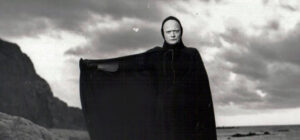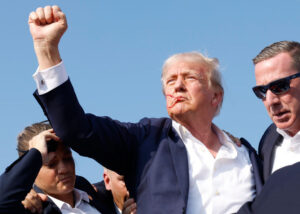It’s one of the sad facts of our miserable climate of miserable prognostications about the state of the cinema that it continually obscures a simple truth: movies are very young. Compared to most artforms, the cinema is still in its infancy. Yet since Louis le Prince’s ultra-brief Roundhay Garden in 1888, cinematic innovation has progressed at a remarkable speed. And perhaps due to a widespread lack of interest in older films (I have heard people refer to films of the Nineties as “old” and met those who refuse to watch anything in black and white), modern audiences accustomed to an enormous repertoire of filmic tricks and techniques are rarely aware of just where these came from, or why.
Yet as even a brief confrontation with the classics of silent cinema will show, certain ideas and “moves” which we now take for granted (e.g. insert shots, cross-cutting, alternation between close-up and wide) were already present then, developing out of a real necessity and a growing sense of the adaptivity of the audience. That is, as silent cinema grew into its great flourishing of the 1910s and Twenties, it was fast becoming a medium unparalleled in its ability to shape the expectations and attentions of its viewers. And among the giant innovators of the era, there remain a small handful of names whose enormous reputations have stayed essentially intact a century later: D.W. Griffith, F.W. Murnau, Charlie Chaplin, Buster Keaton — and Fritz Lang, whose landmark fantasy epic Die Nibelungen marks its centenary this year. The film (and its director) has ultimately had an inescapable influence on everything that came after — not only in cinema, but in the whole of European and American popular culture.
Born to a converted-Catholic Jewish mother and a Moravian father in Austria, in 1890, Lang’s life conformed remarkably to the trajectory of the early 20th century. The stories of his early career have been told and retold over the years: there was his youthful sojourn to Paris to study painting, his enlistment in the Austrian army during the First World War, then a move to Berlin at the dawn of the Weimar Republic. Next came his first great period as a director, at the behemoth German UFA studios (then the largest outside of Hollywood), a series of masterpieces spanning the 15 years between his initial films in 1919, and the classic sound pictures M (1931) and The Testament of Doctor Mabuse (1933).
The Nazis would ban The Testament for being plainly critical of the party, which led Joseph Goebbels himself to reach out to Lang in conciliation, offering him a place in the newly consolidated studios under the Reich Ministry of Public Enlightenment and Propaganda. Lang never took the offer, eventually fleeing Germany via Paris for Hollywood, where he would remain a successful director for two decades. In the midst of this, he managed to either perfect or outright pioneer entire genres, including film noir (in his earlier Mabuse film of 1922), utopian science fiction (Metropolis, 1927), espionage films (Spies, 1928), serial killer movies (M), and of course, epic fantasy in 1924’s Die Nibelungen.
What makes Die Nibelungen so powerful all these years later? For modern viewers, the first and most obvious thing is surely its sheer scale. Filmed over nine months on gigantic exteriors and in cavernous indoor studios, Lang had almost completely free reign to shoot as much and as long as he liked, against mattes, projections, and sets the size of which few films have managed since. The later French auteur theories of the Cahiers du Cinéma posited any director as primary author of a given film, and Lang was often cited as one of the perfect exemplars of the paradigm. Yet reports from the sets of his great UFA films suggest he might better be referred to as a general: at the head of a small army of technicians and designers, he had more or less total authority over the building, filming, and post-production processes.
The entire project was pitched at a mythic scale. The two halves of the film, Siegfried and Kriemhild’s Revenge, total close to five hours long — epic by any era’s standards. Woven by Lang’s then-wife Thea von Harbou out of the traditional myth, Richard Wagner’s opera and a 19th-century theatrical version of the story, the two films tell the tale of the great Nordic/Germanic hero and symbol of Teutonic pride, Siegfried. The first recounts his battle against a dragon, his feats on behalf of the Burgundian King Gunther, his marriage to Kriemhild, and his final betrayal. In the second half, the despairing widow Kriemhild uses a strategic marriage to Atilla the Hun to destroy the Burgundians entirely.
Much has been made of the film’s relationship with German Expressionism, which was as defining to the art and culture of the time as Sigmund Freud’s psychoanalysis. Beginning with The Cabinet of Dr. Caligari (1919), the German cinema dealt intimately with the emerging theories of art the Expressionists were espousing. The great film historian Lotte Eisner lays this out best in her influential book The Haunted Screen (1952), defining the goals of Expressionism as a pure abstraction almost at war with nature. The Expressionists sought — often in those weighty, untranslatable terms of German philosophy — to apocalyptically repudiate everything that had come before, whether it be Impressionism, Naturalism, or Romanticism. In Eisner’s words, what they were ultimately expressing was “that the world has become so ‘permeable’ that, at any one moment, Mind, Spirit, Vision & Ghosts seem to gush forth, exterior facts are continuously being transformed into interior elements & psychic events are exteriorized”. This, Eisner argued, was the same atmosphere evoked in the classic films of the German cinema.
But while Lang’s film delighted in the permeable, it was doing something else as well. Certainly, there was deeply abstract expression in the broad, slow gestures of the actors; in the mist and rocks where Siegfried wanders; in the general eschewal of realism or psychology in favour of pure, solemn archetypes. But instead of the usual warped planes or jagged lines of more normatively Expressionist movies (if such an oxymoron can be said to exist), Lang filled his frames with enormous, heavy symmetries, with rows of impeccably costumed soldiers, and vast diagonals and arches of buildings. In this, he took inspiration from the mythical paintings of German Romantics such as Arnold Böcklin and Caspar David Friedrich.
The influence of Die Nibelungen is still palpable wherever cinema engages in high fantasy. Star Wars, The Lord of the Rings, even Denis Villeneuve’s recent Dune movies would be largely impossible without Lang’s accomplishment. Yet Lang’s film is still somehow more genuinely mythic than those films. This may be partially because of its silence, partially because its old-fashioned effects have aged enough to pass from the merely hokey into an elegant unreality. Peter Jackson’s The Lord of the Rings may be the lone fantasy to have surpassed its scope — yet Jackson’s sense of coverage and place are far more cluttered than Lang’s distant, detached spaces. Villeneuve’s Dune borrows amply from Lang’s shots of people dwarfed by enormous architecture, yet is still bound to naturalistic acting and contemporary demand for psychological ambiguity.
In fact, it may be this last factor which makes Die Nibelungen more authentically mythic, and more alien to our current sensibilities. Contemporary audiences are more or less trained to search for psychology and realism in their plots, in films and TV shows — they need reasons, causes, effects, and complex motivations for their heroes and antiheroes alike.
Die Nibelungen offers no such cushioning. Instead it offers a world without psychology, a world bound by outsized feelings and tragic destinies (though this is not to say the characters lack emotion or motivation). Perhaps the only contemporary filmmaker capable of summoning up such a world is the young American Robert Eggers, who in his three films The Witch, The Lighthouse, and The Northman has — to varying degrees of success — tried to escape modernity and enter the wilds of older, stranger times. It’s surely no accident that his next film is a remake of Murnau’s Nosferatu, another masterpiece of Twenties German cinema.
But contemporaneity aside, Die Nibelungen is still worth deep attention and study precisely because it stands in such sharp relief to our muddled modernity. Particularly in the first Siegfried section, Lang achieves a clarity of image and architecture that is electric. As Siegfried emerges from the mist, perfectly framed between giant rocks and 100-foot trees, the viewer is confronted with a totalising image which wipes aside history, wipes aside nature, and — like the music of Wagner, its nearest analogue — realises something eternal and wholly symbolic.
If this is beginning to sound even vaguely fascistic, well, the reference to Wagner is clear. Goebbels had, after all, offered that special position to Lang because Die Nibelungen had been such a source of pride for Germany. It was a perennial favourite of Hitler’s, and an immense influence on the Nazi propagandist Leni Riefenstahl. It told the story of a favourite hero, central to the concept of Aryan heroism and purity, and of course included many grotesque trollish creatures and barbarous Huns—classic figures for racist caricature, of Jews in particular. Like Wagner, Lang’s work was brimming with big Teutonic ideals such as Weltanschauung and Gesamtkunstwerk — a very consciously Romantic questing after essentially totalitarian experiences. It is hard to watch Die Nibelungen and not see the ways in which it could be used to further such a cause.
Yet the reality of Lang’s later films and his rejection of the Nazi party (knowing full well that even his mother’s conversion would not save him from being legally considered an ethnic Jew) redeem him. It’s hard to imagine watching the vision of slave-class revolt in Metropolis and declaring it fascist. Yet as with Wagner, there is still something haunting left in Lang’s epics. A sense, perhaps, that lofty and mythic ideals can very quickly dovetail into destructive projects, always seeming to embark on a mission to “cleanse” impurities in the name of ostensibly building a better society.
Ultimately, Die Nibelungen survives its era in a way that many other films cannot. Its power derives from an extraordinary vision of a great artist, handling a myth which is far older, grander, and stranger than any modern doctrine. To view it now, from the standpoint of this tremulous technocratic century, is to clear one’s mind of psychological dross, to stand in a mist of time out of mind, among those ghostly abstractions of mind and spirit. It is to get a glimpse into one of the greatest secrets of the cinema — that myth is far from gone, that myth is only sleeping, waiting for a mind to take and hold onto, from a light, projected like an eye, on a screen.
Disclaimer
Some of the posts we share are controversial and we do not necessarily agree with them in the whole extend. Sometimes we agree with the content or part of it but we do not agree with the narration or language. Nevertheless we find them somehow interesting, valuable and/or informative or we share them, because we strongly believe in freedom of speech, free press and journalism. We strongly encourage you to have a critical approach to all the content, do your own research and analysis to build your own opinion.
We would be glad to have your feedback.
Source: UnHerd Read the original article here: https://unherd.com/



